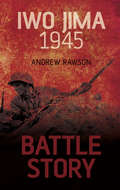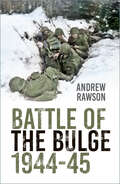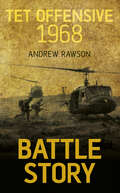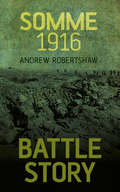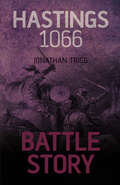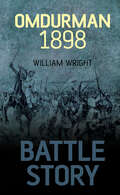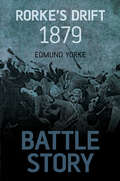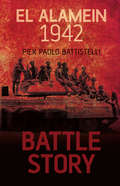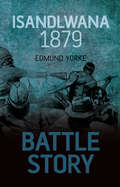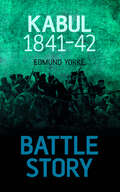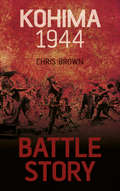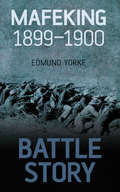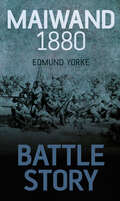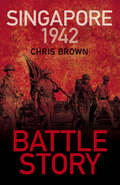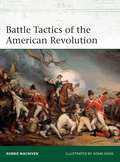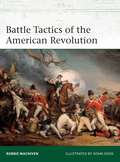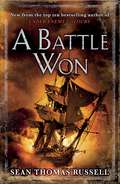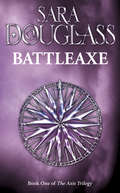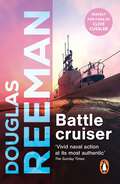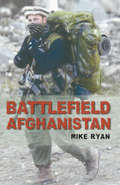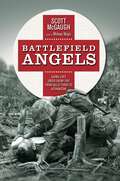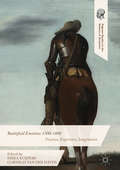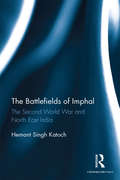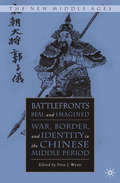- Table View
- List View
Battle Story: Iwo Jima 1945 (Battle Story Ser. #1)
by Andrew RawsonOperation Detachment, the US invasion of Iwo Jima on 19 February 1945, was the first campaign on Japanese soil and resulted in some of the fiercest fighting in the Pacific. If you truly want to understand what happened and why – read Battle Story. Detailed profiles explore the leaders, tactics and equipment of the US and Japanese armies. Nine specially commissioned maps track the progress of the battle and the shifting frontlines. Rare photographs place you in the centre of the unfolding action. Diary extracts and quotes give you a soldier’s eye-view of the battle. Orders of Battle reveal the composition of the opposing forces’ armies. Packed with fact boxes, this short introduction is the perfect way to explore this important battle.
Battle Story: The Battle Of The Bulge 1944-45 (Battle Story Ser.)
by Andrew RawsonIn December 1944 the German military made their final attempt to end the Second World War by throwing in all their reserves in a desperate attempt to shatter the Allied lines. After breaking through the American-held sector in the Ardennes, two Panzer armies headed for the bridges over the River Meuse. However, a combination of poor planning, bad weather, tortuous terrain and above all, the determined defence of key towns and villages, such as Bastogne and St Vith, delayed the advance. The Allies were able to hold the northern and southern shoulders of the attack, hemming the Germans in. The Bulge had been created, and as the fortunes of battle were reversed, the Allies struck back. This book gives a clear, concise account of those dramatic days at the end of 1944, supported by a timeline of events and orders of battle. Over fifty photographs illustrate the events during this momentous campaign.
Battle Story: Tet Offensive 1968 (Battle Story Ser.)
by Andrew RawsonBy the end of January 1968 the American people thought their armed forces were winning in South Vietnam after three years of escalating confl ict. Then the North Vietnamese Army and Viet Cong struck back, hitting military and political targets across the country. While the NVA and Viet Cong suffered a military defeat, they dealt a huge blow to US support for the war. If you want to understand what happened and why - read Battle Story. Detailed profiles examine the background of the opposing commanders, as well as the contrasting tactics and equipment of their fighting forces. Contemporary accounts reveal the true story of this pivotal battle and its consequences for the Vietnam War. Specially commissioned maps analyse the key developments during the battle. Excellent photographs place the reader at the centre of the fighting. Orders of battle show the composition of the opposing forces’ armies.
Battle Story: Tragedy And Triumph (Battle Story Ser. #10)
by Andrew RobertshawThe Battle of the Somme raged from 1 July to 18 November 1916 and was one of the bloodiest fought in military history. It has come to signify for many the waste and bloodshed of the First World War as hundreds of thousands of men on all sides lost their lives fighting over small gains in land. Yet, this battle was also to mark a turning point in the war and to witness new methods of warfare, such as all-arms integrated attacks, with infantry units and the new Tank Corps fighting alongside each other. In this Battle Story, Andrew Robertshaw seeks to lift the battle out of its controversy and explain what really happened and why. Complete with detailed maps and photographs, as well as fascinating facts and profiles of the leaders, this is the best introduction to this legendary battle.
Battle Story: Hastings 1066 (Battle Story Ser. #8)
by Jonathan TriggIn 1066 the most significant battle on English soil – and arguably the most important in British history – took place some six miles northwest of Hastings. A king would die on the battlefield and a new dynasty would be established. The fighting exemplified the superiority of an all-arms combined attack employing foot soldiers, cavalry and archers against massed infantry. To understand what happened and why – read Battle Story. Photographs of the battlefield today, artist’s interpretations and of course reproductions from the Bayeux tapestry place you in the centre of the action. Easy-to-read maps plot each development in the struggle. Descriptions of the weaponry, armour and tactics of the combatants help explain why the famous housecarls of England were obliterated for all time. Packed with fact boxes, this short introduction is the perfect way to explore a turning point in British and European history.
Battle Story: Omdurman 1898 (Battle Story Ser.)
by William WrightThe battle took place at Kerreri, 11km north of Omdurman in the Sudan. Kitchener commanded a force of 8,000 British regulars and a mixed force of 17,000 Sudanese and Egyptian soldiers. He arrayed his force in an arc around the village of Egeiga close to the bank of the Nile, where a gunboat flotilla waited in support, facing a wide, flat plain with hills rising to the left and right. The British and Egyptian cavalry were placed on either flank. Al-Taashi's followers, known as Ansar and sometimes referred to as Dervishes, numbered around 50,000, including some 3,000 cavalry. In a few hours and at a loss of less than 400 officers and men killed and wounded, the Anglo-Egyptian army defeated the 50,000 brave tribesmen who charged their enemy, regardless of the hail of Maxim bullets, many of them armed only with spears, swords and ancient chainmail armour.In concise detail, with orders of battle, maps and over fifty images, the author shows how Omdurman was a superb example of tactics in warfare. First-hand accounts from both sides help the reader to understand all the horrors and glory of that day including the famous charge of the 21st Lancers, often called the last great cavalry charge of the British Army. This was arguably the height of British Empire military dominance.
Battle Story: Anatomy Of An Epic Zulu War Siege (Battle Story Ser.)
by Edmund YorkeThe small garrison based at Rorke's Drift in South Africa is forever immortalised in British history as one of the Army's most glorious moments. The garrison was defended by 139 British soldiers with c.300 African colonial troops under their command when, on 22 January 1879, they were attacked by a Zulu force of nearly 4,000 warriors. Out numbered by nearly twenty to one, the British soldiers constructed a makeshift defence and fought throughout the night. Their tenacity and bravery ensured that the British retained the garrison and won the battle. Their acts in the face of this overwhelming onslaught saw 11 Victoria Crosses being awarded to the British garrison - the highest number ever awarded for a single engagement. Rorke's Drift restored the British public's faith in the Army after the disaster of Isandlwana and the battle was famously portrayed in the film Zulu. Battle Story: Rorke's Drift explores the men and action at this most legendary of battles.
Battle Story: El Alamein 1942
by Pier Paolo BattistelliThe Second Battle of El Alamein marked a major turning point in the Western Desert Campaign of the Second World War. El Alamein saw tow of the greatest generals of the war pitted against each other: Rommel and Montgomery. Through key profiles and a chapter devoted to 'The Armies' Battle Story: El Alamein explores what made these men inspired leaders and what led to their respective defeat and victory. Montgomery's success ensured that the Axis army was unable to occupy Egypt and therefore gain control of the Suez Canal or the Middle Eastern oil fields, thereby preventing a major source of income and power for them. The background and impact of the battle are explored in separate chapters, so offering the reader a clear insight into why what happened in this remote part of Egypt was so central to the Allied cause. Through quotes and maps the text explore the unfolding action of the battle and puts the reader on the frontline. If you truly want to understand what happened and why - read Battle Story.
Battle Story: Isandlwana 1879
by Edmund YorkeOn 22 January 1879 a 20,000-strong Zulu army attacked 1,700 British and colonial forces. The engagement saw primitive weapons of spears and shields clashing with the latest military technology. However, despite being poorly equipped, the numerically superior Zulu force crushed the British troops, killing 1,300 men, whilst only losing 1,000 of their own warriors. It was a humiliating defeat for the British Army, who had been poorly trained and who had underestimated their enemy. The defeat ensured that the British had a renewed respect for their opponents and changed their tactics, rather than fighting in a straight, linear formation, known as the Thin Red Line they adopted an entrenched system or close order foundations. The defeat caused much consternation throughout the British Empire, who had assumed that the Zulu were no match for the British Army and thus the army was greatly reinforced and went on to victory at Rorke's Drift. Battle Story: Isandlwana puts you at the forefront of the action.
Battle Story: Kabul 1841-42 (Battle Story Ser.)
by Edmund YorkeKabul is a name that has had much resonance in current affairs over the last few years, however its place in military history can be charted much further back to the first British incursions into Afghanistan during the 19th century. The First Anglo-Afghan War saw British India attempting to obtain power over Central Asia by gaining control of Afghanistan. The British had little understanding or appreciation of the terrain or tribal warfare in Afghanistan and incurred heavy casualties, despite being far superior in training and weaponry than the Afghan warriors they faced. In 1841 the British, having held Kabul for several years in an attempt to stop the Afghans colluding with the Russians, relaxed their grip on the garrison, allowing the Afghans to rebel, leading to the slaughter of over 16,000 British and Indian troops and camp followers. The outrage from the disaster resounded throughout the British Empire and reinforcements were sent to Afghanistan in 1842 to quell the Afghan troops. However, a rash of uprisings broke out around Kabul, leading to the murder of Indian sepoys and the imprisonment of British officers. In retribution an army was sent to support the British retreat from Afghanistan, laying waste to the city of Kabul on their way.
Battle Story: Kohima 1944 (Battle Story Ser.)
by Dr Chris BrownKohima was the turning point in the Japanese invasion of India, witnessing the end of their attempt to overthrow the British Raj. It was a bitter battle fought in three stages, spanning three months and ending with the siege of Imphal. Losses on both sides were heavy, with the Japanese suffering their greatest land defeat thus far in the war. Against the odds and an enemy who nearly refused to give in, the British Army resisted the Japanese and their victory paved the way for the reconquest of Burma. Battle Story: Kohima explores the historical context of this critical point in the war in Asia, the personalities of the opposing armies and offers a blow-by-blow account of the battle.
Battle Story: Mafeking 1899-1900 (Battle Story Ser.)
by Edmund YorkeThe Siege of Mafeking remains one of the most renowned actions of the Second Boer War, with the British Army defeating a Boer force of up to 8,000 men with barely 1,500 troops. In a siege that lasted 217 days, Robert Baden-Powell and his troops withheld attack from the Boers against all the odds and Mafeking was finally relieved on 17 May 1900. It caused much public excitement in Victorian Britain, with Baden-Powell emerging as a national hero. If you want to understand what happened and why – read Battle Story. One of the most famous, if contoversial, battles of the Second Boer War – memorialised across South Africa, Canada and the United Kingdom The Siege of Mafeking was instrumental in turning Robert Baden-Powell (later founder of the Scouts) into a national hero Includes significant contribution from South African, Canadian and Australian troops
Battle Story: Maiwand 1880 (Battle Story Ser.)
by Edmund YorkeThe Battle of Maiwand was a key clash in the Second Anglo-Afghan War and one of the most serious defeats of the British Army during the ‘Great Game’. British and Indian troops, in an attempt to intercept Afghan forces at the Maiwand Pass, disastrously underestimated the strength of the enemy and were heavily defeated. If you want to understand what happened and why – read Battle Story. Detailed profiles explore the personalities of the British and Afghan leaders, Brigadier General George Burrows and Ayub Khan. Diary extracts and quotes detail the intense fighting and the causes of the British defeat. Maps examine the movements of the British and Afghan forces as they clashed at the Maiwand Pass Contemporary images place the reader at the forefront of the unfolding action. Orders of battle show the composition of the opposing forces’ armies. Packed with fact boxes, this short introduction is the perfect way to explore this crucial battle.
Battle Story: Singapore 1942 (Battle Story Ser.)
by Dr Chris BrownThe Fall of Singapore remains a crushing defeat that sent shockwaves around the British Empire during the Second World War. Singapore had always been seen as an impenetrable fortress that would protect the British Empire’s stake in the Far East – a legacy of the great days of global dominion. The British Army were aware of the threat to Singapore and Malaya from the first days after Pearl Harbor, but they viewed the Japanese Army as an inferior fighting force, incapable of standing up to the defences and trained troops of the British. Yet, in December 1941 the Japanese launched a swift attack on the Singapore airfields, nearly wiping out the entire fleet of RAF frontline aeroplanes. On 10 December the Japanese also destroyed two of the Royal Navy’s premier battleships off the Malay coast. Suddenly, the fate of Singapore rested solely in the hands of the Army. Despite having 90,000 British soldiers posted in Singapore they were quickly overwhelmed by the speed and ferocity of the invading Japanese forces, numbering 75,000 men. The brutality of the Japanese tactics and their sheer ferocity shocked the British and they were soon forced to retreat. By January/February 1942 the British last stand melted away and the Japanese swept into the city, slaughtering those who stood in their way. Over 100,000 men were taken prisoner and many thousands (possibly up to 50,000) residents of the city were massacred. To understand what happened and why read Battle Story.
Battle Tactics of the American Revolution (Elite)
by Robbie MacNivenThe American Revolution presented a series of unique tactical challenges to its competing factions. For Britain, the Army would be forced to re-learn many of the lessons from the Seven Years' War. After the debacle of Concord and Bunker Hill, the British implemented a range of changes throughout the Army, including the modification of accepted tactical doctrine. Additionally, the British formed alliances with various independent German states. The soldiers they provided thus answered to different armies. How much their tactics adapted during the war, therefore varied from state to state.The Continental Army was founded in 1775 and was initially heavily styled on its British opponents. That began to change in 1778 thanks to the efforts of Prussian officer Baron Friedrich Wilhelm von Steuben. Following their formal alliance with the colonies in 1778, France deployed military assets to North America. French officers also provided tactical advice to the Continental Army, and vice versa, particularly when they worked together successfully during the siege of Yorktown in 1781.Featuring specially commissioned artwork, this absorbing study investigates the various participants' battlefield tactics, casting light on how tactical theory and battlefield experience shaped the conduct of battle in the American Revolution.
Battle Tactics of the American Revolution (Elite)
by Robbie MacNivenThe American Revolution presented a series of unique tactical challenges to its competing factions. For Britain, the Army would be forced to re-learn many of the lessons from the Seven Years' War. After the debacle of Concord and Bunker Hill, the British implemented a range of changes throughout the Army, including the modification of accepted tactical doctrine. Additionally, the British formed alliances with various independent German states. The soldiers they provided thus answered to different armies. How much their tactics adapted during the war, therefore varied from state to state.The Continental Army was founded in 1775 and was initially heavily styled on its British opponents. That began to change in 1778 thanks to the efforts of Prussian officer Baron Friedrich Wilhelm von Steuben. Following their formal alliance with the colonies in 1778, France deployed military assets to North America. French officers also provided tactical advice to the Continental Army, and vice versa, particularly when they worked together successfully during the siege of Yorktown in 1781.Featuring specially commissioned artwork, this absorbing study investigates the various participants' battlefield tactics, casting light on how tactical theory and battlefield experience shaped the conduct of battle in the American Revolution.
A Battle Won: Charles Hayden Book 2 (Charles Hayden #2)
by Sean Thomas RussellWinter 1793 - the Reign of Terror rips through revolutionary France, as every able-bodied man is pressed into military service. The city of Toulon has turned itself over to the British - the red ensign of Lord Admiral Hood's flagship, Victory, offering a defiant symbol of protection to its people. In Plymouth, Master and Commander Charles Hayden is summoned to the port admiral - his orders are to return to the ill-fated frigate, HMS Themis. Placed in temporary command, he is to join the escort for the last convoy of the season - braving the wintry seas to supply Hood's fleet in the Mediterranean. Hayden's uncanny knack for attracting the attention of the French navy sees the Themis thrown back into action only hours out of port. Soon, Hayden's captaincy and military skill are stretched to their utmost as he finds himself at the vanguard of this brutal clash of empires.
Battleaxe: Book One Of The Axis Trilogy
by Sara DouglassEpic fantasy in the tradition of Trudi Canavan, Fiona McIntosh and Robert Jordan.
Battlecruiser: an adrenaline-fuelled, all-action naval adventure from the master storyteller of the sea (The\modern Naval Fiction Library #4)
by Douglas ReemanThe Battlecruiser - in their time this class of ships was considered one of the great triumphs of the Royal Navy, as swift as a destroyer but packing a deadly firepower equal to any ship afloat. But the ships had one fatal flaw: their armour could be pierced by a single enemy shell. The Battle of Jutland exposed this Achilles' heel, then further disasters followed in the next world war with the tragic sinkings of the Hood and Repulse.1943 - Of all her class, HMS Reliant and one other have survived. Reliant has the reputation of a lucky ship but when Captain Guy Sherbrooke joins her he knows he could be her last captain. As Britain prepares to invade occupied Europe, Reliant will be thrown head first into the conflagration. All those who sail in her know that there can be no half measures: only death or glory awaits HMS Reliant.
Battlefield Afghanistan
by Mike RyanFrom interviews with his numerous contacts among the coalition forces stationed in Afghanistan, Mike Ryan has done what journalists have so far been unable to do. Battlefield Afghanistan is the first thorough-going account of the war in the former Taliban state: not the politics behind the conflict, but the actual situation for the men on the ground. Far from simply 'keeping the peace,' coalition forces in Afghanistan are currently involved in full-scale warfare with both al-Qaeda militants and the forces of the resurgent Taliban. Battlefield Afghanistan tells the real, inside story of the men under fire, based upon first-hand evidence from members of 3 Para, 16 Air Assault Brigade, the Royal Marines and the Special Forces community, together with the views and experiences of the US and French troops. As their accounts indicate, the hostilities faced have proved to be far greater than was anticipated, and the situation in Afghanistan far more serious than the politicians would like the public to realise.
Battlefield Angels: Saving Lives Under Enemy Fire From Valley Forge to Afghanistan
by Scott McGaughAuthor, journalist, and USS Midway Museum spokesman Scott McGaugh reveals the riveting stories of the men and women who save lives on the front lines in Battlefield Angels, the first book about battlefield medicine in the US military. Told from the point of view of the unsung heroes who slide into bomb craters and climb into blazing ships, this unique look at medicine in the trenches traces the history of the military medical corps and the contributions it has made to America's health, for example, how the military medical corps pioneered the ambulance concept, emergency medevac helicopters, hospital designs, and contagious disease prevention. McGough also details how the military medical corps has adopted medical science discoveries, field tested them in battle, adapted them, and proved their value.
Battlefield Emotions 1500-1800: Practices, Experience, Imagination (Palgrave Studies in the History of Emotions)
by Erika Kuijpers Cornelis van der HavenThis book explores changes in emotional cultures of the early modern battlefield. Military action involves extraordinary modes of emotional experience and affective control of the soldier, and it evokes strong emotional reactions in society at large. While emotional experiences of actors and observers may differ radically, they can also be tightly connected through social interaction, cultural representations and mediatisation. The book integrates psychological, social and cultural perspectives on the battlefield, looking at emotional behaviour, expression and representation in a great variety of primary source material. In three steps it discusses the emotional practices in the army, the emotional experiences of the individual combatant and the emotions of the mediated battlefield in the visual arts.
The Battlefields of Imphal: The Second World War and North East India
by Hemant Singh KatochIn 1944, the British Fourteenth Army and the Japanese Fifteenth Army clashed around the town of Imphal, Manipur, in North East India in what has since been described as one of the greatest battles of the Second World War. Over 200,000 soldiers from several nations fought in the hills and valley of Manipur on the India–Burma (Myanmar) frontier. This book is the first systematic mapping of the main scenes of the fighting in the critical Battle of Imphal. It connects the present with the past and links what exists today in Manipur with what happened there in 1944. The events were transformative for this little-known place and connected it with the wider world in an unparalleled way. By drawing on oral testimonies, written accounts and archival material, this book revisits the old battlefields and tells the untold story of a place and people that were perhaps the most affected by the Second World War in India. The volume will be of great interest to scholars and researchers of military history, especially the Second World War, defence and strategic studies, area studies, and North East India.
The Battlefields of Imphal: The Second World War and North East India
by Hemant Singh KatochIn 1944, the British Fourteenth Army and the Japanese Fifteenth Army clashed around the town of Imphal, Manipur, in North East India in what has since been described as one of the greatest battles of the Second World War. Over 200,000 soldiers from several nations fought in the hills and valley of Manipur on the India–Burma (Myanmar) frontier. This book is the first systematic mapping of the main scenes of the fighting in the critical Battle of Imphal. It connects the present with the past and links what exists today in Manipur with what happened there in 1944. The events were transformative for this little-known place and connected it with the wider world in an unparalleled way. By drawing on oral testimonies, written accounts and archival material, this book revisits the old battlefields and tells the untold story of a place and people that were perhaps the most affected by the Second World War in India. The volume will be of great interest to scholars and researchers of military history, especially the Second World War, defence and strategic studies, area studies, and North East India.
Battlefronts Real and Imagined: War, Border, and Identity in the Chinese Middle Period (The New Middle Ages)
by D. WyattThis collection examines the cultural and intellectual dimensions of war and its resolution between Han Chinese and the various ethnically dissimilar peoples surrounding them during the crucial 'middle period' of Chinese history.
